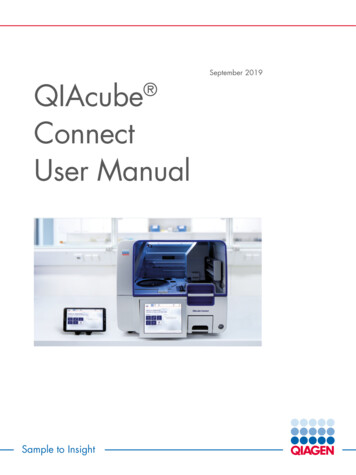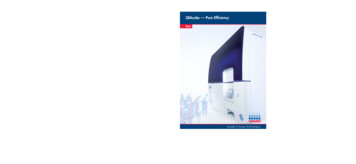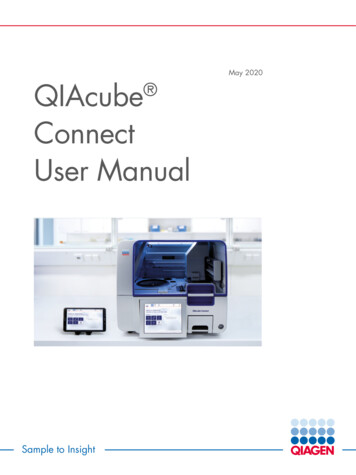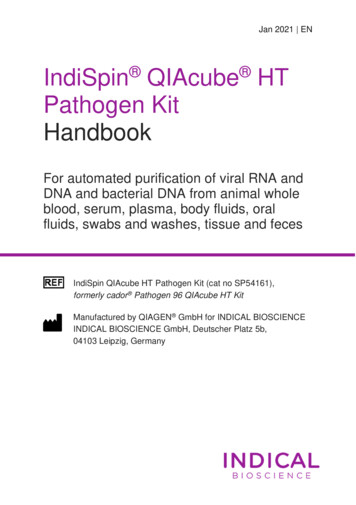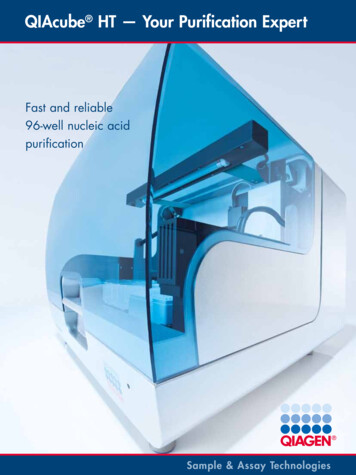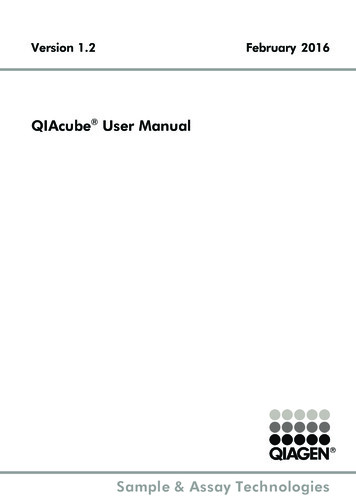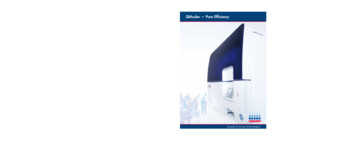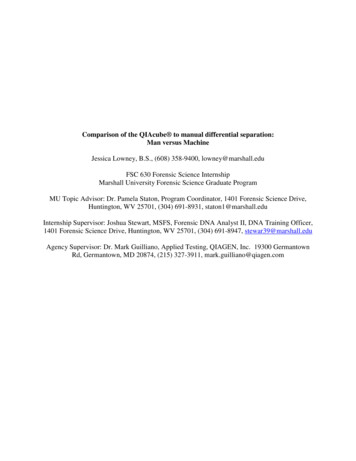
Transcription
Comparison of the QIAcube to manual differential separation:Man versus MachineJessica Lowney, B.S., (608) 358-9400, lowney@marshall.eduFSC 630 Forensic Science InternshipMarshall University Forensic Science Graduate ProgramMU Topic Advisor: Dr. Pamela Staton, Program Coordinator, 1401 Forensic Science Drive,Huntington, WV 25701, (304) 691-8931, staton1@marshall.eduInternship Supervisor: Joshua Stewart, MSFS, Forensic DNA Analyst II, DNA Training Officer,1401 Forensic Science Drive, Huntington, WV 25701, (304) 691-8947, stewar39@marshall.eduAgency Supervisor: Dr. Mark Guilliano, Applied Testing, QIAGEN, Inc. 19300 GermantownRd, Germantown, MD 20874, (215) 327-3911, mark.guilliano@qiagen.com
Lowney 2AbstractSexual assault is a serious public safety concern worldwide, with the resulting caseload backlogposing significant challenges for forensic laboratories. Each sexual assault kit is likely to containa number of samples with female-male mixtures on which a differential extraction must beperformed. Differential extraction is the process of separating sexual assault victim epithelialcells from the perpetrator sperm cells in order to obtain an assailant profile. Unfortunately,differential extraction is a lengthy process, requiring repeated pipetting and centrifugation.Furthermore, due to factors such as experience, the quality and consistency of separation may bevariable between individuals. Because of the reagent cost, time, and manual work involved inworking with these cases, sexual assault backlogs have unfortunately become commonplace. Inan effort to identify ways to reduce these backlogs and benefit a scientist’s workflow, it is worthevaluating the qualities of automated processes. This study focused on determining the utility ofthe QIAGEN (Hilden, Germany) QIAcube for differential separation of samples, andcompared it to the current manual method. The QIAcube was originally designed to extractnucleic acids and proteins, and it is capable of centrifuging, vortexing, pipetting reagents, andextracting a supernatant from a pellet. This study evaluated the QIAcube ’s abilities, using acustom protocol, to perform differential separations on up to 12 mock sexual assault samples at atime. Experiments included a cross-contamination study using mixed female blood and semen; asensitivity study based on a 1:3 serial dilution of semen, with and without female epithelial cellspresent; a reproducibility study, utilizing mixed female epithelial cells and semen; as well as amatrix or mock evidence study, consisting of a mixture of female epithelial cells and semenpipetted onto different fabric types and swabs. All studies were performed by a novice studentusing the QIAcube . For comparison, the sensitivity and reproducibility studies were also
Lowney 3performed by one or more experienced analysts, using a validated manual separation and washprocedure. Each method was evaluated with respect to cost-effectiveness, time efficiency,reproducibility, and sensitivity. The QIAcube did prove to be a very efficient way to performdifferential separations, with excellent sensitivity, and superior reproducibility. There was nosign of cross-contamination between samples. Conversely, more reagents were wasted with theautomated method. Furthermore, loading the instrument proved to be precarious at first; but theease of training a novice on the instrument had great potential, especially in comparison todifferential extraction training. The instrument may not add hours of hands-free time, with theneed to prepare the reagents and set up the instrument – but it is quite nice to push “Go” andwalk away for about half an hour while the instrument does all the centrifuging and pipetting.Lastly, the factor of general human error – for example, bumping a tube and having to re-pelletsperm cells – is subtracted from the extraction process. In conclusion, the use of the QIAcube has the potential to help a scientist work more efficiently simply by freeing an analyst ortechnician from repetitious pipetting and centrifuging.IntroductionA sexual assault is committed every two minutes in the United States, and approximately 46% ofthese crimes are subsequently reported to the police (RAINN 2009). As a result, there are a largenumber of sexual assault cases to be analyzed, which requires lengthy, work-intensive processingprocedures. In fact, there are so many sexual assault cases that a backlog of rape kits are held upin evidence lockers, waiting for analysis. In an effort to handle the sheer volume of evidencereceived by forensic laboratories, scientists at the Marshall University Forensic Science Center,
Lowney 4in cooperation with Dr. Mark Guilliano from QIAGEN , have evaluated a relatively newinstrument and its ability to perform differential separation.Differential extraction is the process of separating cell types based on their ease of lysis, and thenextracting the DNA to obtain cell-type specific profiles. Sperm cells from the perpetrator aremore difficult to lyse than the epithelial cells of the victim due to the presence of many disulfidebonds across the structure of the sperm cell membrane. They are also denser. In order toseparate the sample based on cell type, one can lyse the epithelial cells, centrifuge the spermcells into a pellet, remove the supernatant containing epithelial material, wash the sperm pellet,and finally lyse the sperm cells. Ideally, the sperm fraction would yield a perpetrator-onlyprofile. For many years, this process, referred to as “differential extraction,” is what has beenperformed in forensic laboratories to separate the victim’s DNA from that of the perpetrator.Unfortunately, differential extraction is a lengthy, process involving intensive manual labor.Due to the nature of manual techniques, error and inconsistencies between laboratories, analysts,and individual samples may occur. This delay in processing the backlog, and the potential forvariability, provide an opportunity to explore a way to better serve the justice system, victims ofsexual assault, and wrongly accused individuals. At a roundtable meeting in Washington, DC,led by the U.S. Department of Justice’s Office on Violence Against Women, it was determinedthat “more research on how to perform DNA analyses faster, better, and at a lower cost” wasnecessary to facilitate a victim-centered approach to sexual assault cases (2010). One way ofaccomplishing this goal may be to investigate using automation. This study investigates the
Lowney 5abilities of the QIAcube to help assist technology to move forward in the field of differentialextraction and sexual assault kit processing.In 2007, QIAGEN released the QIAcube (QIAGEN 2012), an instrument designed for thelysis of cells and DNA extraction. It is capable of performing a range of functions, includingpipetting, centrifuging, vortexing, and the separation of a supernatant from pelleted material(Figure 1).Figure 1: Interior of the QIAcube Photograph by Joshua Stewart, MSFSWhile the QIAcube does come with several programs readily available for download, it is alsopossible to create custom protocols to fit the diverse needs of many types of laboratories andstudies. In this study, two custom protocols were used to perform the differential separation ofsperm cells from epithelial cells – a process which would take a human hours to perform byhand. This study aims to investigate the degree to which the QIAcube may aid forensic DNA
Lowney 6analysts in working more efficiently; as well as to evaluate any other possible advantages ordisadvantages to using automation to process these types of samples.Previously, studies have been performed using the QIAcube for medical research; fordetermining time since deposition in bloodstains (Hanson et al. 2011); and in forensic validationstudies, comparing the QIAcube to other instruments or methods of extraction (Lee et al. 2010;Leon, Guilliano, and Della Manna; Phillips et al. 2010). One study compared the QIAcube totwo other automated systems, the MagNA Pure LC (Roche Diagnostics, Mannheim, Germany)and the Magtration System 12GC (Precision Science Co., Ltd., Chiba, Japan), in processinghuman whole blood (Lee et al. 2010). They concluded that all three instruments performedcomparably, leaving it up to laboratories to decide which is best for their purposes. A secondvalidation study was performed comparing the QIAcube to two manual methods for extractingnucleic acids from buccal swabs and blood samples on filter paper (Phillips et al. 2010). Theyconcluded that the QIAcube ’s results were comparable to manual methods, but that the amountof time and effort was reduced with the use of the automated procedure. Finally, a study wasperformed to determine the feasibility of using the QIAcube to perform differential separationof mixed samples. The results were promising, generating profiles comparable to manualseparation with no cross-contamination between samples (Leon, Guilliano, and Della Manna).Materials and Methods160 µL Buffer G2, 10 µL Proteinase K, and 40 µL 1M DTT were added to to 10 µL of rawsemen sample. The mixture was vortexed vigorously for 10 seconds, then incubated at 70 C for
Lowney 710 minutes at 900 rpm on a thermomixer. After the incubation, the sample was vortexed foranother 10 seconds and purified on the QIAGEN EZ1 . Finally, it was quantitated usingPromega Plexor HY.After this initial quantitation, a semen dilution was prepared with 1X Phosphate Buffered Saline,pH 7.2 (PBS). This dilution was used for the reproducibility study and as the startingconcentration for a 1:3 dilution series for the sensitivity studies. An approximate 1:2 dilutionwith female saliva was also prepared using PBS, which was used in the sensitivity,reproducibility, and matrix studies. For the cross-contamination study, female blood was mixedwith semen for the positive samples.Automated SeparationBefore placing them on the QIAcube , the samples prepared for automated differentialseparation and lysis each (except for the cross-contamination study) received 210 µL of a lysismixture, which was a ratio of 200 µL Buffer G2 to 10 µL Proteinase K to 1 µL carrier RNA.Samples were then vortexed, incubated at 56 C on a heat block for 1.5 to 2 hours, vortexedagain, and placed on the QIAcube for centrifugation and separation using the first customprotocol designed by QIAGEN . After the first protocol had finished its run, the student wouldcap the epithelial cell fractions and run the QIAcube ’s second custom protocol, which wouldwash the pellet with Buffer G2 and lyse the sperm cells using a mixture of 160 µL Buffer G2 to10 µL Proteinase K to 40 µL DTT to 1 µL carrier RNA. After removing the sperm fractionsfrom the QIAcube , they were vortexed for ten seconds vigorously and placed on a thermomixer
Lowney 8for 10 minutes at 70 C and 900 rpm. All samples were then vortexed again for ten seconds andplaced on the QIAGEN EZ1 for DNA purification.Manual SeparationManual samples underwent the validated procedure for differential extraction of caseworksamples. 200-250 µL Buffer G2 and 10 µL Proteinase K were added to the samples, which wereincubated for 1-2 hours at 56 C. The tubes were centrifuged at 13,200 rpm for 5 minutes, andthe supernatant (the epithelial cell fraction) was transferred to an EZ1 sample tube. 1 µL ofcarrier RNA was added to the epithelial cell fraction, which was then ready for EZ1 DNApurification. The sperm fraction was washed at least three times with 500 µL Buffer G2. Afterwashing, 160 µL Buffer G2, 10 µL Proteinase K, 40 µL 1M DTT, and 1 µL carrier RNA wereadded to the sperm fraction. It was vortexed vigorously for 10 seconds, incubated at 70 C for 10minutes at 900 rpm, and placed on the EZ1 for DNA purification.A cost analysis was performed by summing the initial cost of reagents and other suppliesrequired to perform a differential separation on one sample. The automated and manual methodswere compared.All samples, manual and automated, were quantitated using Promega (Madison, WI) Plexor HY kits and placed on Applied Biosystems (Grand Island, NY) 7500 Real-Time PCRSystems. Amplification was performed using Promega PowerPlex 16 HS, and capillaryelectrophoresis was performed on the Applied Biosystems 3130 or 3130xl.Electropherograms were analyzed using GeneMapper ID version 1.2.3 with a 50 RFU analysis
Lowney 9threshold and a marker specific stutter ratio filter. The QIAcube was lent to the MUFSC byQIAGEN .Cross-contamination studyTwo runs were performed on the QIAcube for the purpose of determining the risk of crosscontamination between samples. One run placed positive samples in odd positions and negativesamples in even positions (Figure 2). The other run was the opposite, with positives in the evenpositions and negatives in the odd positions.Positive samples contained 20 µL of female blood, 2 µL of semen, 250 µL of G2 buffer, and 10µL of Proteinase K. Negative samples contained 250 µL of G2 buffer and 10 µL of ProteinaseK. After the separation, sperm fractions were digested as previously described.Figure 2: The QIAcube centrifuge with 12 rotor positionsPhotograph by Joshua Stewart, MSFS
Lowney 10Sensitivity & linearity studyPart A: Semen onlyA 1:3 semen dilution series was prepared (Table 1), and 50µL of each semen dilution wasdifferentially extracted.Table 1: Semen dilution series (per Mark Guilliano from QIAGEN )A720ul of APBS to7200ulB240ul of A48015.300.1030.383Dilution NameSemen Serial Dilution(ul)Calculatedng/50ul dilution45.91Calculatedul semen0.308ng/ulin eluate1.148C240ul of B4805.100.0340.128D240ul of C4801.700.0110.043E240ul of D4800.570.0040.014F240ul of E4800.190.0010.005The set of dilutions A-F was created in duplicate to test the QIAcube ’s sensitivity to decreasingamounts of semen. A second duplicated set of dilutions A-F were separated manually forcomparison.Part B: Semen dilution series with female salivaA quadruplicate set of dilutions A-D (Table 1) was added to 50µL of an approximate 1:2 dilutionof female saliva. One duplicate set of dilutions was separated manually, while the secondduplicate set was separated using the QIAcube .Reproducibility studySamples were prepared using 50 µL of semen dilution A (Table 1) and 50 µL of the 1:2 salivadilution. Six sets of three samples were separated manually by different members of theMarshall University Forensic Science Center DNA laboratory. The rest of the samples were
Lowney 11separated using the QIAcube in three sets of six (minus one lost sample), for a total of 35samples tested.Matrix studyThis study may also be referred to as a “mock evidence” type study, using several differentprepared cloth types (towel, jeans, blue sock, brown shirt, and white shirt) and a swab. Thematrices were digested at 56 C for about 1.5 hours, in a spin basket, with the same 200 µLBuffer G2 to 10 µL Proteinase K to 1 µL carrier RNA mixture. They were then centrifuged for 5minutes at 13,000 rpm to draw the liquid off the substrate. The baskets and substrates wereremoved, and extraction continued on the QIAcube as usual.ResultsCross-Contamination StudyTwo representative positive samples were amplified and typed. Both samples yielded theexpected profiles (Figures 3 and 4). Three of the control negative samples contained small peaksthat aligned with three allele bins: bin 30 of D21S11, bin Y of Amelogenin, and bin 17 of vWA(Figure 5). However, neither the D21 nor the vWA suspected alleles listed match those of thecontrol male or female samples. No peaks were called by GeneMapper ID. The remaining 21negative controls showed no evidence of contamination.
Lowney 12Sensitivity StudySemen-only samplesThe samples from the QIAcube showed full profiles in the sperm fraction through dilution Dand for one of the two E dilutions. For the other E and dilution F, dropout was noted. Themanual samples displayed dropout starting at dilution D, and seemed to have a higher level ofdropout than the automated samples. When the peak heights from capillary electrophoresis weretotaled for each dilution, the QIAcube appeared to be more sensitive than the manual methodwith overall higher peak heights (Figure 6). Both the manual and automated methods seemed tofollow the expected threefold decrease in slope.Semen with salivaQuantitation data for both the automated and manual methods showed the expected threefolddecrease in concentration for the sperm fractions (Figure 7). The epithelial fraction seemed toshow that more DNA may have been extracted with the use of the QIAcube . Some dropoutwas noted in some of the epithelial fractions for both the manual and automated methods.Reproducibility StudyThe quantitation of samples from the QIAcube displayed a higher level of consistency than themanual samples for both the epithelial and the sperm fractions (Figures 8 and 9). Both themanual and automated methods gave the expected DNA profiles.
Lowney 13Matrix or Mock Evidence StudyQuantitation of the sperm and epithelial fractions both showed lower values than for the previousliquid-only studies. Upon amplification and capillary electrophoresis of the samples, dropoutwas noted in most of them, especially the sperm fractions. However, the observed dropout wasnot consistent, even among the same fabric types (Figure 10).Cost Analysis (per Season Seferyn, MSFS)The instrument itself costs 17,802. In addition, it costs about 24.79 to set up the QIAcube (Table 2), as a certain level of reagent is required in the reagent bottles, and specialized plasticsare also needed. After the initial expense, it costs about 17.78 to separate and extract onesample. In comparison, the manual method costs about 18.58.Table 2: QIAcube Set-Up and EZ1 Purification Cost (per Season Seferyn, MSFS)8.104166667Numberneeded216.20833Tips - 1000uL QIAGEN, wide-bore0.077734375100.777344Rotor Adapter and Elution Tube0.15083333310.150833Surplus Proteinase K0.02671403.738DTT (35000uL)0.0033714296402.157714Buffer G2 (260mL) - 6900uL surplus needed1.75684615411.756846Total for e-cell & sperm cell--24.78907ItemAmount per set-upEZ1 expense (cartridge, G2, Pro K, etc.)TotalDiscussionAlthough some small peaks in bins were noted during the cross-contamination study, these werenot determined to necessarily be true alleles. If a Y allele was truly present, it could have comefrom either the sperm sample or any of the three men working on the QIAcube that day.
Lowney 14Furthermore, since the other suspect peaks registered at very small height values, and since theydid not match the known profiles, the instrument was deemed not to be responsible for any crosscontamination.The results of both the sensitivity and reproducibility tests showed that the QIAcube ’sperformance at least equaled that of an experienced analyst. It may have even proved to be moresensitive in generating a profile from a sperm pellet. Also, there was a marked improvement inconsistency with the use of the QIAcube , which had been pitted against the combinedexperience of 30 years of manual technique.The matrix study presents many questions which could be addressed with further study. Firstly,during incubation, the spin basket sits relatively high in the tube. It may be worth investigatingwhether the sample is reaching the proper temperature during incubation. It would also be worthcomparing the results of the matrix study to a liquid-only control, as well as a manualcomparison. Lastly, it may be worth following QIAGEN’s protocol exactly, rather than makingan attempt to mirror the other methods performed during this study.Although there is an initial set-up cost for the instrument, the amount per sample is almost adollar less for the automated process than the manual one. If running more than one sample, andmore than one run of the instrument per day, the set-up expenses would most certainly bereduced. Therefore, except for the initial cost of the instrument, the expense of running theQIAcube is roughly equivalent to manual differential separation.
Lowney 15ConclusionsOne important way to better serve the justice system and victims of sexual assault is to “Developenhanced training for new DNA analysts, since training is currently a resource-heavy, timeconsuming process [and e]xplore ways to streamline training for criminalists” (US DOJ 2010).The QIAcube addressed this issue mainly by being easy to understand and use, as well asallowing some hands-free time to work more efficiently. A novice could be trained very quicklyon the instrument, which could drastically reduce training time for new analysts, and allow a newworker to progress to handling backlogged cases more quickly. The instrument introduced norisk of contamination and general human error was eliminated. The QIAcube is a viablealternative to manual differential separation, reducing repetitive motions and providing equal orgreater consistency and sensitivity.AcknowledgementsThe authors would like to express their gratitude toward the Marshall University ForensicScience Center DNA Laboratory for hosting this project and providing laboratory personnel andequipment. Heather Harrah-Lea, MS, and Season Seferyn, MSFS, have the thanks of the authorsfor performing the manual portions of the sensitivity study and for helping with cost analysis,respectively. The authors would also like to acknowledge QIAGEN for lending the QIAcube to the laboratory; and the National Institute of Justice, whose generous grant made theseexperiments possible.
Lowney 16ReferencesHanson, E., Albornoz, A., and Ballantyne, J. 2011. Validation of the hemoglobin (Hb) hypsochromic shiftassay for determination of the time since deposition (TSD) of dried bloodstains. Forensic ScienceInternational: Genetics Supplement Series 3(1): e307-e308. Available online i/S1875176811001545. Accessed May 2012.Lee, J., Park, Y., Choi, J. R., Lee, E. K., and Kim, H. 2010. Comparisons of Three Automated Systems forGenomic DNA Extraction in a Clinical Diagnostic Laboratory. Yonsei Medical Journal 51(1): 104110. Available online at:http://synapse.koreamed.org/DOIx.php?id 10.3349/ymj.2010.51.1.104. Accessed May 2012.Leon, A., Guilliano, M., and Della Manna, A. “Feasibility of using the QIAGEN QIAcube to helpAutomate the Differential Extraction Process.” Alabama Department of Forensic Sciences,Birmingham AL; QIAGEN, Germantown, MD.Phillips, K., McCallum, N., and Welch, L. 2010. A comparison of methods for forensic DNA extraction:Chelex-100 and the QIAGEN DNA Investigator Kit (manual and automated). Forensic ScienceInternational: Genetics 6(2): 282-285. Available online i/S1872497311000949. Accessed May 2012.QIAGEN. 2012. QIAcube Wins ALA New Product Award. [Online.] Available ssreleaseview.aspx?pressreleaseid 86.Accessed July 2012.Rape, Abuse & Incest National Network (RAINN). 2009. Statistics. [Online.] Available from:http://www.rainn.org/statistics/. Accessed July 2012.U.S. Department of Justice (US DOJ) Office on Violence Against Women. 2010. Eliminating the Rape KitBacklog: A Roundtable to Explore a Victim-Centered Approach. In Summary of the Proceedings,Washington, DC, May 11-12, 2010. Available from: ummary-10262010.pdf. Accessed July 2012.
Lowney 17Figures 3-10Figure 3: Cross-contamination study: epithelial cell fraction electropherogramAn example electropherogram from one of the positive controls of the cross-contamination study.The epithelial fraction of the sample yielded the expected profiles.Figure 4: Cross-contamination study sperm fraction electropherogramAn example electropherogram from the same positive control’s sperm fraction. The expectedprofiles were generated.
Lowney 18Figure 5: Cross-contamination study: peaks in negative controlsa.b.c.A few very low peaks were noticed in three negative controls of the cross-contamination study.All three peaks were below the 50 RFU analysis threshold. Two of the bins (a. and c.) did notmatch the known alleles from the blood or semen donors. It was determined that, if these weretrue alleles rather than “noise,” they were not due to the performance of the QIAcube .Figure 6: Sensitivity studySerial semen dilution: automated versus manual extraction100000Total peak height (rfu)Automated extractionManual WashExpected slope100001000CDEF1:3 Serial dilution of semen (two trials)Total peak height of two trials per test (manual and automated) was summed after capillaryelectrophoresis and compared to a slope that decreased threefold. Dilutions A and B are notshown because they were normalized before amplification. The automated extraction shows aslightly higher peak height than the manual extraction.
Lowney 19Figure 7: Sensitivity studyAverage Human Quantitation ValuesLog Average quantitation (ng/µL)101ABCDAutomated - EpithelialAutomated - SpermManual - Epithelial0.1Manual - SpermExpected slope (sperm)0.01Serial dilutionConcentration of DNA (ng/µL)Quantitation values of the sensitivity study (semen with saliva) showed that the sperm fractionsof both the manual and automated extraction methods followed the expected decreasing trend.The automated method yielded slightly higher quantitation results in both fractions than themanual method.1.600Figure 8: Reproducibility studyQuantitation of sperm fractions: manual versus omatedextraction0.8000.6000.4000.2000.000123456789 10 11 12 13 14 15 16 17 18ReplicatesQuantitation values of the sperm fractions for the reproducibility study. All samples containedapproximately the same amount of sperm and saliva dilution. The quantitation values of theautomated extraction show more consistent and slightly higher quantitation results than those ofthe manual extraction method. CV for manual extraction was 43%; CV for automated extractionwas 9%.
Lowney 20Figure 9: Reproducibility studyQuantitation of epithelial fractions: manual versus automated methodsConcentration of DNA (ng/µL)10.0009.0008.0007.0006.0005.000Manual extraction4.000Automated extraction3.0002.0001.0000.000123456789 10 11 12 13 14 15 16 17 18ReplicatesReproducibility study: Much like the sperm fractions, the epithelial fractions showed greaterconsistency with the automated method than with the manual method, although the quantitationvalues are lower on average. CV for manual extraction was 20%; CV for automated extractionwas 12%.Figure 10: Matrix study: Sample sperm fractions from two cuttings of jeansa.
Lowney 21b.Dropout was noted with the sperm fractions of the matrix study samples. This dropout was notnecessarily consistent within the same fabric type. This example of blue jean fabric shows thatthe two samples had entirely different levels of dropout in their sperm fractions.
possible to create custom protocols to fit the diverse needs of many types of laboratories and studies. In this study, two custom protocols were used to perform the differential separation of . from the QIAcube , they were vortexed for ten seconds vigorously and placed on a thermomixer . Lowney 8 for 10 minutes at 70 C and 900 rpm. All .


